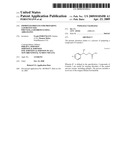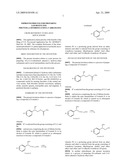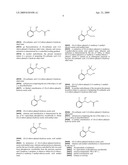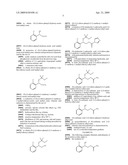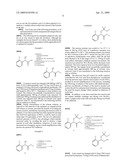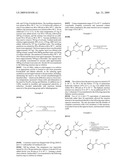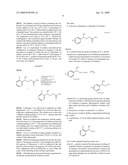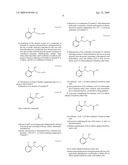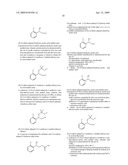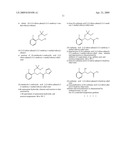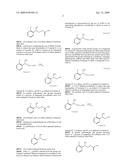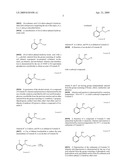Patent application title: IMPROVED PROCESS FOR PREPARING 2-(SUBSTITUTED PHENYOL)-2-HYDROXY-ETHYL-CARBAMATES
Inventors:
Frank Porstmann (Stetten, CH)
Thomas Meler (Schaffhausen, CH)
IPC8 Class: AC07C26904FI
USPC Class:
560163
Class name: Carbamic acid cyclic alcohol moiety aromatic alcohol moiety
Publication date: 2009-04-23
Patent application number: 20090105498
ates to a process of preparing a compound of
Formula I:
##STR00001##
Wherein R1 is defined in the specification. Compounds of Formula I
are useful for treating disorders of the central nervous system,
including epilepsy. The process includes a novel use of the reagent
lithium borohydride.Claims:
1. A process of preparing a compound of Formula I: ##STR00044##
wherein:R1 is selected from the group consisting of Cl, F, and
Br;said process comprising the use of lithium borohydride to reduce the
ester intermediate of Formula II, to an alcohol of Formula III, which is
carried on in subsequent reactions to become a compound of Formula I.
##STR00045## wherein PG is a protecting group derived from an ether,
wherein said ether is selected from the group consisting of
2-methoxy-1-propene, dihydropyran, methyl vinyl ether, ethyl vinyl ether,
and 5,6-dihydro-4-methoxy-2H-pyran.
2. The process of claim 1, wherein R1 is 2-chloro.
3. The process of claim 2, further comprising the following steps a and b.a) esterification of (S)-(2-chloro-phenyl)-hydroxy-acetic acid, ##STR00046## (S)-(2-chloro-phenyl)-hydroxy-acetic acidwith a C.sub.(1-4)alcohol, selected from the group consisting of: methanol, ethanol, n-propanol, iso-propanol, n-butanol, iso-butanol, sec-butanol, and tert-butanol: wherein said esterification is characterized by the use of: 0.025 to 0.4 equivalents phosphorous oxychloride to obtain an ester of Formula IV. ##STR00047## b) protection of the alcohol moiety of a compound of Formula IV, wherein said protection is characterized by the use of acidic catalysis controlled by left over acid from phosphorous oxychloride from the previous reaction and an ether selected from the group consisting of: 2-methoxy-1-propene, dihydropyran, methyl vinyl ether, ethyl vinyl ether, and 5,6-dihydro-4-methoxy-2H-pyran to obtain a compound of Formula II, wherein R1 is 2-chloro, and PG is as defined in Formula II. ##STR00048##
4. The process of claim 3 further comprising steps d, e, f, and g as shown below:d) Reaction of an alcohol of Formula III ##STR00049## with a carbonyl compound, ##STR00050## wherein X and Y are leaving groups independently selected from the group consisting of bromo, chloro, imidazolyl, and phenoxy;wherein said reaction is characterized by a reaction temperature: -10 to 65.degree. C., to yield a carbonyl compound of Formula V. ##STR00051## e) Reaction of a compound of Formula V with ammonium hydroxide or ammonia, wherein said reaction is characterized by reaction temperature: 0 to 55.degree. C. to form the carbamate of Formula VI. ##STR00052## f) Deprotection of the carbamate of Formula VI, wherein said deprotection is characterized by the use of an acid selected from the group consisting of phosphoric acid, hydrochloric acid, and sulfuric acid to form (S)-carbamic acid 2-(2-chloro-phenyl)-2-hydroxy-ethyl ester ##STR00053## (S)-carbamic acid 2-(2-chloro-phenyl)-2-hydroxy-ethyl esterg) Recrystalization of (S)-carbamic acid 2-(2-chloro-phenyl)-2-hydroxy-ethyl ester, wherein said recrystalization is characterized by a controlled cooling gradient.
5. A process of preparing (S)-carbamic acid 2-(2-chloro-phenyl)-2-hydroxy-ethyl ester ##STR00054## (S)-carbamic acid 2-(2-chloro-phenyl)-2-hydroxy-ethyl estersaid process comprising the use of the steps a, b, and c as described below:a) Methyl esterification of (S)-(2-chloro-phenyl)-hydroxy-acetic acid, ##STR00055## (S)-(2-chloro-phenyl)-hydroxy-acetic acidwherein said esterification is characterized by the use of 0.1 equivalents phosphorous oxychloride to obtain (S)-(2-chloro-phenyl)-hydroxy-acetic acid methyl ester. ##STR00056## (S)-(2-chloro-phenyl)-hydroxy-acetic acid methyl esterb) protection of (S)-(2-chloro-phenyl)-hydroxy-acetic acid methyl ester, wherein said protection is characterized by the use of acidic catalysis controlled by left over acid from phosphorous oxychloride from the previous reaction and 2-methoxy-1-propene, to obtain to obtain (S)-(2-chloro-phenyl)-(1-methoxy-1-methyl-ethoxy)-acetic acid methyl ester. ##STR00057## (S)-(2-chloro-phenyl)-(1-methoxy-1-methyl-ethoxy)-acetic acid methyl esterc) reduction of (S)-(2-chloro-phenyl)-(1-methoxy-1-methyl-ethoxy)-acetic acid methyl ester, wherein said reduction is characterized by the use of LiBH4, to obtain (S)-2-(2-chloro-phenyl)-2-(1-methoxy-1-methyl-ethoxy)-ethanol, which is carried on in subsequent reactions to become (S)-carbamic acid 2-(2-chloro-phenyl)-2-hydroxy-ethyl ester. ##STR00058## (S)-2-(2-chloro-phenyl)-2-(1-methoxy-1-methyl-ethoxy)-ethanol
6. A process of preparing (S)-carbamic acid 2-(2-chloro-phenyl)-2-hydroxy-ethyl ester: ##STR00059## (S)-carbamic acid 2-(2-chloro-phenyl)-2-hydroxy-ethyl estersaid process comprising the use of the steps a, b, c, d, e, f, and g as described below:a) methyl esterification of (S)-(2-chloro-phenyl)-hydroxy-acetic acid: ##STR00060## (S)-(2-chloro-phenyl)-hydroxy-acetic acidwherein said methyl esterification is characterized by the use of:10 equivalents of methanol,0.1 equivalents of phosphorous oxychloride,reaction temperature: 40 to 50.degree. C.,partial concentration, andtoluene co-solvent;to obtain (S)-(2-chloro-phenyl)-hydroxy-acetic acid methyl ester. ##STR00061## (S)-(2-chloro-phenyl)-hydroxy-acetic acid methyl esterb) protection of (S)-(2-chloro-phenyl)-hydroxy-acetic acid methyl ester, wherein said protection is characterized by the use of:acidic catalysis controlled by left over acid from phosphorous oxychloride from the previous step,addition of 1.6 equivalents isopropenyl methyl ether to reaction mixture, and1 extraction with water;to obtain (S)-(2-chloro-phenyl)-(1-methoxy-1-methyl-ethoxy)-acetic acid methyl ester. ##STR00062## (S)-(2-chloro-phenyl)-(1-methoxy-1-methyl-ethoxy)-acetic acid methyl esterc) reduction of (S)-(2-chloro-phenyl)-(1-methoxy-1-methyl-ethoxy)-acetic acid methyl ester, wherein said reduction is characterized by the use of:LiBH4,reaction temperature: 40 to 50.degree. C.,distillation of THF and acetone and Isopropanol (the last one formed during workup procedure by reduction of acetone), and2 extractions with sodium hydroxide solution and NaCl-solution;to obtain (S)-2-(2-chloro-phenyl)-2-(1-methoxy-1-methyl-ethoxy)-ethanol. ##STR00063## (S)-2-(2-chloro-phenyl)-2-(1-methoxy-1-methyl-ethoxy)-ethanole) reaction of (S)-imidazole-1-carboxylic acid 2-(2-chloro-phenyl)-2-(1-methoxy-1-methyl-ethoxy)-ethyl ester ##STR00064## (S)-imidazole-1-carboxylic acid 2-(2-chloro-phenyl)-2-(1-methoxy-1-methyl-ethoxy)-ethyl esterwith ammonium hydroxide, wherein said reaction is characterized by1.60 equivalents of ammonium hydroxide, andreaction temperature: 40 to 50.degree. C.to form (S)-carbamic acid 2-(2-chloro-phenyl)-2-(1-methoxy-1-methyl-ethoxy)-ethyl ester. ##STR00065## (S)-carbamic acid 2-(2-chloro-phenyl)-2-(1-methoxy-1-methyl-ethoxy)-ethyl esterf) deprotection of (S)-carbamic acid 2-(2-chloro-phenyl)-2-(1-methoxy-1-methyl-ethoxy)-ethyl ester, wherein said deprotection is characterized byaddition of 2 equivalents of aq. sulfuric acid, andreaction temperature: 40 to 50.degree. C.to form (S)-carbamic acid 2-(2-chloro-phenyl)-2-hydroxy-ethyl ester. ##STR00066## (S)-carbamic acid 2-(2-chloro-phenyl)-2-hydroxy-ethyl esterg) recrystallization of (S)-carbamic acid 2-(2-chloro-phenyl)-2-hydroxy-ethyl ester,wherein said recrystalization is characterized bymethanol/water 1:4, anduse of a controlled temperature gradient.Description:
CROSS REFERENCE TO RELATED APPLICATIONS
[0001]This application claims priority of the benefits of the filing of U.S. Provisional Application Ser. No. 60/980,877, filed Oct. 18, 2007. The complete disclosures of the aforementioned related U.S. patent application is/are hereby incorporated herein by reference for all purposes.
BRIEF DESCRIPTION OF THE INVENTION
[0002]The present invention relates to a new process for preparing (S)-(+)-2-(substituted phenyl)-2 hydroxy-ethyl carbamates and to novel intermediates used in this process.
BACKGROUND OF THE INVENTION
[0003]2-(substituted phenyl)-2 hydroxy-ethyl carbamates and their isomers have been described in U.S. Pat. No. 5,698,588, U.S. Pat. No. 5,854,283, U.S. Pat. No. 6,127,412, U.S. Pat. No. 6,103,759, WO 97/26241, and WO 03/053916 as compounds useful for treating disorders of the central nervous system. Said disorders include convulsions, epilepsy, stroke, muscles spasms, neuropathic pain, and migraine. A preferred disorder is epilepsy.
SUMMARY OF THE INVENTION
[0004]The present invention relates to a process of preparing a compound of Formula l:
##STR00002##
wherein:
[0005]R1 is selected from the group consisting of Cl, F, and Br;
[0006]said process comprising the use of lithium borohydride to reduce the ester intermediate of Formula II, to an alcohol of Formula III, which is carried on in subsequent reactions to become a compound of Formula I.
##STR00003##
wherein PG is a protecting group derived from an ether, wherein said ether is selected from the group consisting of 2-methoxy-1-propene, dihydropyran, methyl vinyl ether, ethyl vinyl ether, and 5,6-dihydro-4-methoxy-2H-pyran.
DETAILED DESCRIPTION OF THE INVENTION
[0007]The present invention relates to a process of preparing a compound of Formula I:
##STR00004##
wherein:
[0008]R1 is selected from the group consisting of Cl, F, and Br;
[0009]said process comprising the use of lithium borohydride to reduce the ester intermediate of Formula II, to an alcohol of Formula III, which is carried on in subsequent reactions to become a compound of Formula I.
##STR00005##
wherein PG is a protecting group derived from an ether, wherein said ether is selected from the group consisting of 2-methoxy-1-propene, dihydropyran, methyl vinyl ether, ethyl vinyl ether, and 5,6-dihydro-4-methoxy-2H-pyran.
[0010]In another embodiment, the present invention relates to a process of preparing (S)-carbamic acid 2-(2-chloro-phenyl)-2-hydroxy-ethyl ester:
##STR00006##
[0011](S)-carbamic acid 2-(2-chloro-phenyl)-2-hydroxy-ethyl ester
[0012]said process comprising the use of lithium borohydride to reduce the ester intermediate of Formula II, to an alcohol of Formula III, which is carried on in subsequent reactions to become (S)-carbamic acid 2-(2-chloro-phenyl)-2-hydroxy-ethyl ester.
##STR00007##
wherein R1 is 2-chloro, and PG is as defined in Formula II.
[0013]In another embodiment, the present invention relates to a process of preparing (S)-carbamic acid 2-(2-chloro-phenyl)-2-hydroxy-ethyl ester:
##STR00008##
[0014](S)-carbamic acid 2-(2-chloro-phenyl)-2-hydroxy-ethyl ester
[0015]said process comprising the use of the steps a, b, and c as described below:
[0016]a) esterification of (S)-(2-chloro-phenyl)-hydroxy-acetic acid,
##STR00009##
[0017](S)-(2-chloro-phenyl)-hydroxy-acetic acid
[0018]with a C.sub.(1-4)alcohol, selected from the group consisting of: methanol, ethanol, n-propanol, iso-propanol, n-butanol, iso-butanol, sec-butanol, and tert-butanol: wherein said esterification is characterized by the use of: 0.025 to 0.4 equivalents phosphorous oxychloride to obtain an ester of Formula IV.
##STR00010##
[0019]b) protection of the alcohol moiety of a compound of Formula IV, wherein said protection is characterized by the use of acidic catalysis controlled by left over acid from phosphorous oxychlolide from the previous reaction and an ether selected from the group consisting of: 2-methoxy-1-propene, dihydropyran, methyl vinyl ether, ethyl vinyl ether, and 5,6-dihydro-4-methoxy-2H-pyran to obtain a compound of Formula II,
##STR00011##
wherein R1 is 2-chloro, and PG is as defined in Formula II.
[0020]c) Use of lithium borohydride to reduce the ester intermediate of Formula II, to an alcohol of Formula III, which is carried on in subsequent reactions to become
[0021](S)-carbamic acid 2-(2-chloro-phenyl)-2-hydroxy-ethyl ester.
##STR00012##
wherein R1 is 2-chloro, and PG is as defined in Formula II.
[0022]In another embodiment, the present invention relates to a process of preparing (S)-carbamic acid 2-(2-chloro-phenyl)-2-hydroxy-ethyl ester
##STR00013##
[0023](S)-carbamic acid 2-(2-chloro-phenyl)-2-hydroxy-ethyl ester said process comprising the use of the steps a, b, c, d, e, f, and g as described below:
[0024]a) esterification of (S)-(2-chloro-phenyl)-hydroxy-acetic acid,
##STR00014##
[0025](S)-(2-chloro-phenyl)-hydroxy-acetic acid with a C.sub.(1-4)alcohol, selected from the group consisting of: methanol, ethanol, n-propanol, iso-propanol, n-butanol, iso-butanol, sec-butanol, and tert-butanol: wherein said esterification is characterized by the use of: 0.025 to 0.4 equivalents phosphorous oxychloride to obtain an ester of Formula IV.
##STR00015##
[0026]b) protection of the alcohol moiety of a compound of Formula IV, wherein said protection is characterized by the use of acidic catalysis controlled by left over acid from phosphorous oxychlolide from the previous reaction and an ether selected from the group consisting of: 2-methoxy-1-propene, dihydropyran, methyl vinyl ether, ethyl vinyl ether, and 5,6-dihydro-4-methoxy-2H-pyran to obtain a compound of Formula II
##STR00016##
wherein R1 is 2-chloro, and PG is as defined in Formula II.
[0027]c) Use of lithium borohydride to reduce the ester intermediate of Formula II, to an alcohol of Formula III.
##STR00017##
wherein R1 is 2-chloro, and PG is as defined in Formula II.
[0028]d) Reaction of an alcohol of Formula III
##STR00018##
with a carbonyl compound,
##STR00019##
wherin X and Y are leaving groups independently selected from the group consisting of bromo, chloro, imidazolyl, and phenoxy;
[0029]wherein said reaction is characterized by a reaction temperature: -10 to 65° C., to yield a carbonyl compound of Formula V.
##STR00020##
[0030]e) Reaction of a compound of Formula V with ammonium hydroxide or ammonia, wherein said reaction is characterized by reaction temperature: 0 to 55° C. to form the carbamate of Formula VI.
##STR00021##
[0031]f) Deprotection of the carbamate of Formula VI, wherein said deprotection is characterized by the use of an acid selected from the group consisting of phosphoric acid, hydrochloric acid, and sulfuric acid to form (S)-carbamic acid 2-(2-chloro-phenyl )-2-hydroxy-ethyl ester
##STR00022##
[0032](S)-carbamic acid 2-(2-chloro-phenyl)-2-hydroxy-ethyl ester
[0033]g) Recrystalization of (S)-carbamic acid 2-(2-chloro-phenyl)-2-hydroxy-ethyl ester, wherein said recrystalization is characterized by a controlled cooling gradient.
[0034]In another embodiment, the present invention relates to a process of preparing (S)-carbamic acid 2-(2-chloro-phenyl)-2-hydroxy-ethyl ester
##STR00023##
[0035](S)-carbamic acid 2-(2-chloro-phenyl)-2-hydroxy-ethyl ester
[0036]said process comprising the use of the steps a, b, and c as described below:
[0037]a) Methyl esterification of (S)-(2-chloro-phenyl)-hydroxy-acetic acid,
##STR00024##
[0038](S)-(2-chloro-phenyl)-hydroxy-acetic acid
[0039]wherein said esterification is characterized by the use of 0.1 equivalents phosphorous oxychloride to obtain (S)-(2-chloro-phenyl)-hydroxy-acetic acid methyl ester.
##STR00025##
[0040](S)-(2-chloro-phenyl)-hydroxy-acetic acid methyl ester
[0041]b) protection of (S)-(2-chloro-phenyl)-hydroxy-acetic acid methyl ester, wherein said protection is characterized by the use of acidic catalysis controlled by left over acid from phosphorous oxychlolide from the previous reaction and 2-methoxy-1-propene, to obtain to obtain (S)-(2-chloro-phenyl)-(1-methoxy-1-methyl-ethoxy)-acetic acid methyl ester.
##STR00026##
[0042](S)-(2-chloro-phenyl)-(1-methoxy-1-methyl-ethoxy)-acetic acid methyl ester
[0043]c) reduction of (S)-(2-chloro-phenyl)-(1-methoxy-1-methyl-ethoxy)-acetic acid methyl ester, wherein said reduction is characterized by the use of LiBH4, to obtain (S)-2-(2-chloro-phenyl)-2-(1-methoxy-1-methyl-ethoxy)-ethanol, which is carried on in subsequent reactions to become (S)-carbamic acid 2-(2-chloro-phenyl)-2-hydroxy-ethyl ester.
##STR00027##
[0044](S)-2-(2-chloro-phenyl)-2-(1-methoxy-1-methyl-ethoxy)-ethanol
[0045]In another embodiment of the invention the present invention relates to a process of preparing (S)-carbamic acid 2-(2-chloro-phenyl)-2-hydroxy-ethyl ester:
##STR00028##
[0046](S)-carbamic acid 2-(2-chloro-phenyl)-2-hydroxy-ethyl ester
[0047]said process comprising the use of the steps a, b, c, d, e, f, and g as described below:
[0048]a) methyl esterification of (S)-(2-chloro-phenyl)-hydroxy-acetic acid:
##STR00029##
[0049](S)-(2-chloro-phenyl)-hydroxy-acetic acid
[0050]wherein said methyl esterification is characterized by the use of: [0051]10 equivalents of methanol, [0052]0.1 equivalents of phosphorous oxychloride, [0053]reaction temperature: 40 to 50° C., [0054]partial concentration, and [0055]toluene co-solvent;
[0056]to obtain (S)-(2-chloro-phenyl)-hydroxy-acetic acid methyl ester.
##STR00030##
[0057](S)-(2-chloro-phenyl)-hydroxy-acetic acid methyl ester
[0058]b) protection of (S)-(2-chloro-phenyl)-hydroxy-acetic acid methyl ester, wherein said protection is characterized by the use of: [0059]acidic catalysis controlled by left over acid from phosphorous oxychloride from the previous step, [0060]addition of 1.6 equivalents isopropenyl methyl ether to reaction mixture, and [0061]1 extraction with water;
[0062]to obtain (S)-(2-chloro-phenyl)-(1-methoxy-1-methyl-ethoxy)-acetic acid methyl ester.
##STR00031##
[0063](S)-(2-chloro-phenyl)-(1-methoxy-1-methyl-ethoxy)-acetic acid methyl ester
[0064]c) reduction of (S)-(2-chloro-phenyl)-(1-methoxy-1-methyl-ethoxy)-acetic acid methyl ester, wherein said reduction is characterized by the use of: [0065]LiBH4, [0066]solvents: Aprotic solvents like ethers e.g. THF, diethylether and the like, [0067]hydrocarbons like e.g. toluene, [0068]workup with ketones like e.g. acetone, [0069]reaction temperature: 40 to 50° C., [0070]distillation of THF and acetone, and and isopropanol (the last one formed during workup procedure by reduction of acetone) [0071]2 extractions with sodium hydroxide solution and NaCl-solution;
[0072]to obtain (S)-2-(2-chloro-phenyl)-2-(1-methoxy-1-methyl-ethoxy)-ethanol.
##STR00032##
[0073](S)-2-(2-chloro-phenyl)-2-(1-methoxy-1-methyl-ethoxy)-ethanol
[0074]e) reaction of (S)-imidazole-1-carboxylic acid 2-(2-chloro-phenyl)-2-(1-methoxy-1-methyl-ethoxy)-ethyl ester
##STR00033##
[0075](S)-imidazole-1-carboxylic acid 2-(2-chloro-phenyl)-2-(1-methoxy-1-methyl-ethoxy)-ethyl ester
[0076]with ammonium hydroxide, wherein said reaction is characterized by [0077]1.60 equivalents of ammonium hydroxide, and [0078]reaction temperature: 40 to 50° C.
[0079]to form (S)-carbamic acid 2-(2-chloro-phenyl)-2-(1-methoxy-1-methyl-ethoxy)-ethyl ester.
##STR00034##
[0080](S)-carbamic acid 2-(2-chloro-phenyl)-2-(1-methoxy-1-methyl-ethoxy)-ethyl ester
[0081]f) deprotection of (S)-carbamic acid 2-(2-chloro-phenyl)-2-(1-methoxy-1-methyl-ethoxy)-ethyl ester, wherein said deprotection is characterized by [0082]addition of 2 equivalents of aq. sulfuric acid, and [0083]reaction temperature: 40 to 50° C.
[0084]to form (S)-carbamic acid 2-(2-chloro-phenyl)-2-hydroxy-ethyl ester.
##STR00035##
[0085](S)-carbamic acid 2-(2-chloro-phenyl)-2-hydroxy-ethyl ester
[0086]g) recrystallization of (S)-carbamic acid 2-(2-chloro-phenyl)-2-hydroxy-ethyl ester,
[0087]wherein said recrystalization is characterized by [0088]methanol/water 1:4, and [0089]use of a controlled temperature gradient.
EXAMPLES
[0090]The following examples illustrate embodiments of the invention as they apply to
[0091]the synthesis of
##STR00036##
can we use the (S)-carbamic acid 2-(2-chloro-phenyl)-2-(1-methoxy-1-methyl-ethoxy)-ethyl ester instead of the formula in the text. [0092]Use of any one of the following procedures, or an equivalent thereof yields unexpected advantages that are described below.
[0093]The following are for exemplary purposes only, and are in no way meant to limit the invention. Although the examples shown are where R1 is 2-chloro, those skilled in the art will recognize that the procedures will be applicable for R1 as defined in Formula I.
Example 1
##STR00037##
[0095]A reaction vessel was charged with 300 kg (1607.8 mol) of (S)-2-chloromandelic acid, 519 kg (16199 mol) of methanol, 24.6 kg (160.4 mol) of phosphoric trichloride, 190 kg (1790.4 mol) of trimethoxymethane and 672 kg of toluene, and heated to 40 to 50° C., whereupon a clear solution was formed. The solution was partially concentrated in vacuum until approximately 708 kg of solvents were removed. An additional 708 kg of toluene were added and the distillation in vacuum was repeated until 708 kg of solvents were again removed. Ester IV was transferred to the following reaction step as solution in toluene.
[0096]Partial concentration of the toluene solution, as opposed to full removal of the methanol as reagent/solvent and toluene as solvent, provided the benefit of avoiding the reverse reaction, and thereby increasing the reaction yield. In addition, it was discovered that less than equimolar amounts like 0.025-0.4 equivalents of POCl3 could be used as acid, rather than 2.8 equivalents of HCl. The use of a substochiometrical amounts of POCl3 has advantages which include: increased safety by avoiding the need to destroy a large amount of acid after distillation, reduction of cycle time, decreased use of reagents, and an overall simplification of the process (no gaseous HCl addition).
Example 2
##STR00038##
[0098]The reaction mixture was cooled to 5 to 15° C. A mass of 184 kg (2552 mol) of 2-methoxy-1-propene was slowly added at 5 to 30° C. The resulting solution was stirred for 30 to 120 min at 20 to 30° C. before 24.6 kg (243.1 mol) of anhydrous triethylamine were added. After the pH had been checked to be in the range of 8 to 11, 270 kg of water were added, whereupon a biphasic mixture was formed. The emulsion was stirred for 10 to 30 min, before the layers were separated. The lower aqueous layer was discarded (approximately 305 kg). The organic layer was partially concentrated in vacuum until approximately 300 kg of solvents were removed. Ester II was transferred to the following reaction step as solution.
[0099]The discovery that pH control for acidic catalysis controlled by left over acid from phosphorous oxychloride from the previous step could be used in place of new POCl3 resulted in several simplifications of the process, including the following: avoidance of the need to add additional phosphorous oxychloride, avoidance of the need to monitor and control the pH for optimum ketal formation, and eliminating the need for reactor change which resulted in reduction of cycle time.
[0100]In addition, it was discovered that this reaction did not require multiple washings and drying over Na2SO4; rather, a single water wash with azeotropic drying was found to be sufficient.
Example 3
##STR00039##
[0102]A dry vessel was charged with 91.8 kg (1702.2 mol) potassium borohydrate, 72.0 kg (1698.9 mol) of lithium chloride, and 516 kg of tetrahydrofuran. The resulting suspension was stirred at 40 to 50° C. for 1 to 2 h before the solution of ester II was added over 90 to 180 min at 40 to 50° C. After the addition, the reaction mixture was stirred at 40 to 50° C. for an additional 2.5 to 3.5 h. At the same temperature 271 kg of acetone were added slowly over 60 to 120 min, followed by 240 kg of toluene, and the mixture was stirred for an additional 30 to 60 min at 40 to 50° C. Vacuum distillation was then used to remove 786 kg of solvents. Sodium hydroxide solution (approximately 30% (w/w), 278 kg, 2085 mol) was added, followed by 557 kg of purified water. The resulting emulsion was stirred for 20 to 40 min at 40 to 50° C., and the layers were separated. The lower aqueous layer was discarded (approximately 997 kg). The organic layer was diluted with 240 kg toluene, treated with 300 kg purified water, and 30 kg of sodium chloride. The emulsion is stirred at 40 to 50° C. for 10 to 30 min and the layers were again separated. The aqueous layer (approximately 360 kg) is discarded. The organic layer was partially concentrated in vacuum until approximately 600 kg of solvents were removed. Alcohol III was transferred to the following reaction step as solution.
[0103]Use of LiBH4, either as solid reagent or as solution in an appropriate solvent or formed in situ from potassium borohydride and lithium chloride, as the reducing agent resulted in several improvements to the procedure, including: eliminating the need to use the solvent tetraethyleneglycol dimethyl ether--which can be difficult to remove, lower reaction temperature, increased volume yield, and elimination of the need for Na2SO4 drying and filtration. In addition use of LiBH4 resulted in excellent and unexpected selectivity of reduction. Avoided undesirable side reactions include removal of the protecting group and/or dehalogenation.
Example 4
##STR00040##
[0105]A reaction vessel was charged with 326 kg (2010.5) mol 1,1'-carbonylbis-1H-imidazole and
[0106]540 kg toluene. The suspension was vigorously stirred for 10 to 30 min before the solution of alcohol III was added slowly over 30 min at 15 to 45° C., forming a nearly clear solution. Imidazolide V was transferred to the following reaction step as solution in toluene.
[0107]Using a temperature range of 15 to 45° C. resulted in consistently complete conversion and increased volume yield, when compared to the same reaction run at a temperature range of 0 to 20° C.
Example 5
##STR00041##
[0109]The solution from the previous step was stirred at 35 to 45° C. for 30 to 60 min before 175 kg of ammonium hydroxide solution (25% (w/v), 1.6 eq.) was added slowly within 90 to 180 min at 35 to 45° C. The biphasic reaction mixture was stirred at 35 to 45° C. for an additional 45 to 75 min. Carbamate VI was transferred to the following step in the biphasic reaction mixture.
[0110]Use of 1.6 (1.44-1.77) equivalents of ammonium hydroxide rather than 10 equivalents allowed the reaction mixture to be transferred directly to the following step with no aqueous extractions. The new procedure had the benefits of complete conversion with a low incidence of side reactions, no product losses in the aqueous layers, and increased volume yield.
Example 6
##STR00042##
[0112]The biphasic reaction mixture containing the carbamate VI was treated with 392 kg of purified water, followed by the addition of 311 kg (3171.2 mol, 2 equivalents) of sulfuric acid at 15 to 50° C., followed by an additional 43.5 kg of purified water. The emulsion was stirred at 40 to 50° C. for 45 to 75 min whereupon the crude carbamate I precipitated. The suspension was cooled to 10 to 20° C., followed by centrifugation. The wet product (approximately 360 kg) was washed with 360 kg of purified water in several portions and dried in a tray dryer (drying cabinet) or a mechanical dryer in vacuum and 65 to 75° C. for 0.5 to 24 h.
[0113]Use of 2 equivalents of sulfuric acid allowed the combination of carbamate formation in example 5 with the procedure in example 6. Further the use of 2 equivalents of sulfuric acid at 40 to 50° C. rather than 0.73 equivalents of HCl at 20 to 30° C. resulted in increased yield from 83.7% to 91.6%. Volume yield increased from 70 g/L to 146 g/L, and cycle time was reduced.
Example 7
##STR00043##
[0115]Carbamate I was dissolved in methanol at reflux temperature (˜65° C.) and filtered via a 0.45 μm filter cartridge into a preheated reactor. The solution was cooled with a defined cooling gradient to 18 to 22° C. during which the product started to crystallize.
[0116]Water was added to the suspension, until the methanol/water ratio is 1:4. The suspension was further cooled with a defined gradient to 0-5° C. The suspension was filtered and the resulting cake was washed with water. The wet product was dried under vacuum at 48-52° C. in a drying cabinet or in a mechanical dryer.
[0117]Use of a controlled cooling gradient resulted in a slightly increased volume yield from 118 g/L to 123 g/L and control of the polymorphs.
[0118]While the foregoing specification teaches the principles of the present invention, with examples provided for the purpose of illustration, it will be understood that the practice of the invention encompasses all of the usual variations, adaptations and/or modifications as come within the scope of the following claims and their equivalents.
[0119]All publications disclosed in the above specification are hereby incorporated by reference in full.
Claims:
1. A process of preparing a compound of Formula I: ##STR00044##
wherein:R1 is selected from the group consisting of Cl, F, and
Br;said process comprising the use of lithium borohydride to reduce the
ester intermediate of Formula II, to an alcohol of Formula III, which is
carried on in subsequent reactions to become a compound of Formula I.
##STR00045## wherein PG is a protecting group derived from an ether,
wherein said ether is selected from the group consisting of
2-methoxy-1-propene, dihydropyran, methyl vinyl ether, ethyl vinyl ether,
and 5,6-dihydro-4-methoxy-2H-pyran.
2. The process of claim 1, wherein R1 is 2-chloro.
3. The process of claim 2, further comprising the following steps a and b.a) esterification of (S)-(2-chloro-phenyl)-hydroxy-acetic acid, ##STR00046## (S)-(2-chloro-phenyl)-hydroxy-acetic acidwith a C.sub.(1-4)alcohol, selected from the group consisting of: methanol, ethanol, n-propanol, iso-propanol, n-butanol, iso-butanol, sec-butanol, and tert-butanol: wherein said esterification is characterized by the use of: 0.025 to 0.4 equivalents phosphorous oxychloride to obtain an ester of Formula IV. ##STR00047## b) protection of the alcohol moiety of a compound of Formula IV, wherein said protection is characterized by the use of acidic catalysis controlled by left over acid from phosphorous oxychloride from the previous reaction and an ether selected from the group consisting of: 2-methoxy-1-propene, dihydropyran, methyl vinyl ether, ethyl vinyl ether, and 5,6-dihydro-4-methoxy-2H-pyran to obtain a compound of Formula II, wherein R1 is 2-chloro, and PG is as defined in Formula II. ##STR00048##
4. The process of claim 3 further comprising steps d, e, f, and g as shown below:d) Reaction of an alcohol of Formula III ##STR00049## with a carbonyl compound, ##STR00050## wherein X and Y are leaving groups independently selected from the group consisting of bromo, chloro, imidazolyl, and phenoxy;wherein said reaction is characterized by a reaction temperature: -10 to 65.degree. C., to yield a carbonyl compound of Formula V. ##STR00051## e) Reaction of a compound of Formula V with ammonium hydroxide or ammonia, wherein said reaction is characterized by reaction temperature: 0 to 55.degree. C. to form the carbamate of Formula VI. ##STR00052## f) Deprotection of the carbamate of Formula VI, wherein said deprotection is characterized by the use of an acid selected from the group consisting of phosphoric acid, hydrochloric acid, and sulfuric acid to form (S)-carbamic acid 2-(2-chloro-phenyl)-2-hydroxy-ethyl ester ##STR00053## (S)-carbamic acid 2-(2-chloro-phenyl)-2-hydroxy-ethyl esterg) Recrystalization of (S)-carbamic acid 2-(2-chloro-phenyl)-2-hydroxy-ethyl ester, wherein said recrystalization is characterized by a controlled cooling gradient.
5. A process of preparing (S)-carbamic acid 2-(2-chloro-phenyl)-2-hydroxy-ethyl ester ##STR00054## (S)-carbamic acid 2-(2-chloro-phenyl)-2-hydroxy-ethyl estersaid process comprising the use of the steps a, b, and c as described below:a) Methyl esterification of (S)-(2-chloro-phenyl)-hydroxy-acetic acid, ##STR00055## (S)-(2-chloro-phenyl)-hydroxy-acetic acidwherein said esterification is characterized by the use of 0.1 equivalents phosphorous oxychloride to obtain (S)-(2-chloro-phenyl)-hydroxy-acetic acid methyl ester. ##STR00056## (S)-(2-chloro-phenyl)-hydroxy-acetic acid methyl esterb) protection of (S)-(2-chloro-phenyl)-hydroxy-acetic acid methyl ester, wherein said protection is characterized by the use of acidic catalysis controlled by left over acid from phosphorous oxychloride from the previous reaction and 2-methoxy-1-propene, to obtain to obtain (S)-(2-chloro-phenyl)-(1-methoxy-1-methyl-ethoxy)-acetic acid methyl ester. ##STR00057## (S)-(2-chloro-phenyl)-(1-methoxy-1-methyl-ethoxy)-acetic acid methyl esterc) reduction of (S)-(2-chloro-phenyl)-(1-methoxy-1-methyl-ethoxy)-acetic acid methyl ester, wherein said reduction is characterized by the use of LiBH4, to obtain (S)-2-(2-chloro-phenyl)-2-(1-methoxy-1-methyl-ethoxy)-ethanol, which is carried on in subsequent reactions to become (S)-carbamic acid 2-(2-chloro-phenyl)-2-hydroxy-ethyl ester. ##STR00058## (S)-2-(2-chloro-phenyl)-2-(1-methoxy-1-methyl-ethoxy)-ethanol
6. A process of preparing (S)-carbamic acid 2-(2-chloro-phenyl)-2-hydroxy-ethyl ester: ##STR00059## (S)-carbamic acid 2-(2-chloro-phenyl)-2-hydroxy-ethyl estersaid process comprising the use of the steps a, b, c, d, e, f, and g as described below:a) methyl esterification of (S)-(2-chloro-phenyl)-hydroxy-acetic acid: ##STR00060## (S)-(2-chloro-phenyl)-hydroxy-acetic acidwherein said methyl esterification is characterized by the use of:10 equivalents of methanol,0.1 equivalents of phosphorous oxychloride,reaction temperature: 40 to 50.degree. C.,partial concentration, andtoluene co-solvent;to obtain (S)-(2-chloro-phenyl)-hydroxy-acetic acid methyl ester. ##STR00061## (S)-(2-chloro-phenyl)-hydroxy-acetic acid methyl esterb) protection of (S)-(2-chloro-phenyl)-hydroxy-acetic acid methyl ester, wherein said protection is characterized by the use of:acidic catalysis controlled by left over acid from phosphorous oxychloride from the previous step,addition of 1.6 equivalents isopropenyl methyl ether to reaction mixture, and1 extraction with water;to obtain (S)-(2-chloro-phenyl)-(1-methoxy-1-methyl-ethoxy)-acetic acid methyl ester. ##STR00062## (S)-(2-chloro-phenyl)-(1-methoxy-1-methyl-ethoxy)-acetic acid methyl esterc) reduction of (S)-(2-chloro-phenyl)-(1-methoxy-1-methyl-ethoxy)-acetic acid methyl ester, wherein said reduction is characterized by the use of:LiBH4,reaction temperature: 40 to 50.degree. C.,distillation of THF and acetone and Isopropanol (the last one formed during workup procedure by reduction of acetone), and2 extractions with sodium hydroxide solution and NaCl-solution;to obtain (S)-2-(2-chloro-phenyl)-2-(1-methoxy-1-methyl-ethoxy)-ethanol. ##STR00063## (S)-2-(2-chloro-phenyl)-2-(1-methoxy-1-methyl-ethoxy)-ethanole) reaction of (S)-imidazole-1-carboxylic acid 2-(2-chloro-phenyl)-2-(1-methoxy-1-methyl-ethoxy)-ethyl ester ##STR00064## (S)-imidazole-1-carboxylic acid 2-(2-chloro-phenyl)-2-(1-methoxy-1-methyl-ethoxy)-ethyl esterwith ammonium hydroxide, wherein said reaction is characterized by1.60 equivalents of ammonium hydroxide, andreaction temperature: 40 to 50.degree. C.to form (S)-carbamic acid 2-(2-chloro-phenyl)-2-(1-methoxy-1-methyl-ethoxy)-ethyl ester. ##STR00065## (S)-carbamic acid 2-(2-chloro-phenyl)-2-(1-methoxy-1-methyl-ethoxy)-ethyl esterf) deprotection of (S)-carbamic acid 2-(2-chloro-phenyl)-2-(1-methoxy-1-methyl-ethoxy)-ethyl ester, wherein said deprotection is characterized byaddition of 2 equivalents of aq. sulfuric acid, andreaction temperature: 40 to 50.degree. C.to form (S)-carbamic acid 2-(2-chloro-phenyl)-2-hydroxy-ethyl ester. ##STR00066## (S)-carbamic acid 2-(2-chloro-phenyl)-2-hydroxy-ethyl esterg) recrystallization of (S)-carbamic acid 2-(2-chloro-phenyl)-2-hydroxy-ethyl ester,wherein said recrystalization is characterized bymethanol/water 1:4, anduse of a controlled temperature gradient.
Description:
CROSS REFERENCE TO RELATED APPLICATIONS
[0001]This application claims priority of the benefits of the filing of U.S. Provisional Application Ser. No. 60/980,877, filed Oct. 18, 2007. The complete disclosures of the aforementioned related U.S. patent application is/are hereby incorporated herein by reference for all purposes.
BRIEF DESCRIPTION OF THE INVENTION
[0002]The present invention relates to a new process for preparing (S)-(+)-2-(substituted phenyl)-2 hydroxy-ethyl carbamates and to novel intermediates used in this process.
BACKGROUND OF THE INVENTION
[0003]2-(substituted phenyl)-2 hydroxy-ethyl carbamates and their isomers have been described in U.S. Pat. No. 5,698,588, U.S. Pat. No. 5,854,283, U.S. Pat. No. 6,127,412, U.S. Pat. No. 6,103,759, WO 97/26241, and WO 03/053916 as compounds useful for treating disorders of the central nervous system. Said disorders include convulsions, epilepsy, stroke, muscles spasms, neuropathic pain, and migraine. A preferred disorder is epilepsy.
SUMMARY OF THE INVENTION
[0004]The present invention relates to a process of preparing a compound of Formula l:
##STR00002##
wherein:
[0005]R1 is selected from the group consisting of Cl, F, and Br;
[0006]said process comprising the use of lithium borohydride to reduce the ester intermediate of Formula II, to an alcohol of Formula III, which is carried on in subsequent reactions to become a compound of Formula I.
##STR00003##
wherein PG is a protecting group derived from an ether, wherein said ether is selected from the group consisting of 2-methoxy-1-propene, dihydropyran, methyl vinyl ether, ethyl vinyl ether, and 5,6-dihydro-4-methoxy-2H-pyran.
DETAILED DESCRIPTION OF THE INVENTION
[0007]The present invention relates to a process of preparing a compound of Formula I:
##STR00004##
wherein:
[0008]R1 is selected from the group consisting of Cl, F, and Br;
[0009]said process comprising the use of lithium borohydride to reduce the ester intermediate of Formula II, to an alcohol of Formula III, which is carried on in subsequent reactions to become a compound of Formula I.
##STR00005##
wherein PG is a protecting group derived from an ether, wherein said ether is selected from the group consisting of 2-methoxy-1-propene, dihydropyran, methyl vinyl ether, ethyl vinyl ether, and 5,6-dihydro-4-methoxy-2H-pyran.
[0010]In another embodiment, the present invention relates to a process of preparing (S)-carbamic acid 2-(2-chloro-phenyl)-2-hydroxy-ethyl ester:
##STR00006##
[0011](S)-carbamic acid 2-(2-chloro-phenyl)-2-hydroxy-ethyl ester
[0012]said process comprising the use of lithium borohydride to reduce the ester intermediate of Formula II, to an alcohol of Formula III, which is carried on in subsequent reactions to become (S)-carbamic acid 2-(2-chloro-phenyl)-2-hydroxy-ethyl ester.
##STR00007##
wherein R1 is 2-chloro, and PG is as defined in Formula II.
[0013]In another embodiment, the present invention relates to a process of preparing (S)-carbamic acid 2-(2-chloro-phenyl)-2-hydroxy-ethyl ester:
##STR00008##
[0014](S)-carbamic acid 2-(2-chloro-phenyl)-2-hydroxy-ethyl ester
[0015]said process comprising the use of the steps a, b, and c as described below:
[0016]a) esterification of (S)-(2-chloro-phenyl)-hydroxy-acetic acid,
##STR00009##
[0017](S)-(2-chloro-phenyl)-hydroxy-acetic acid
[0018]with a C.sub.(1-4)alcohol, selected from the group consisting of: methanol, ethanol, n-propanol, iso-propanol, n-butanol, iso-butanol, sec-butanol, and tert-butanol: wherein said esterification is characterized by the use of: 0.025 to 0.4 equivalents phosphorous oxychloride to obtain an ester of Formula IV.
##STR00010##
[0019]b) protection of the alcohol moiety of a compound of Formula IV, wherein said protection is characterized by the use of acidic catalysis controlled by left over acid from phosphorous oxychlolide from the previous reaction and an ether selected from the group consisting of: 2-methoxy-1-propene, dihydropyran, methyl vinyl ether, ethyl vinyl ether, and 5,6-dihydro-4-methoxy-2H-pyran to obtain a compound of Formula II,
##STR00011##
wherein R1 is 2-chloro, and PG is as defined in Formula II.
[0020]c) Use of lithium borohydride to reduce the ester intermediate of Formula II, to an alcohol of Formula III, which is carried on in subsequent reactions to become
[0021](S)-carbamic acid 2-(2-chloro-phenyl)-2-hydroxy-ethyl ester.
##STR00012##
wherein R1 is 2-chloro, and PG is as defined in Formula II.
[0022]In another embodiment, the present invention relates to a process of preparing (S)-carbamic acid 2-(2-chloro-phenyl)-2-hydroxy-ethyl ester
##STR00013##
[0023](S)-carbamic acid 2-(2-chloro-phenyl)-2-hydroxy-ethyl ester said process comprising the use of the steps a, b, c, d, e, f, and g as described below:
[0024]a) esterification of (S)-(2-chloro-phenyl)-hydroxy-acetic acid,
##STR00014##
[0025](S)-(2-chloro-phenyl)-hydroxy-acetic acid with a C.sub.(1-4)alcohol, selected from the group consisting of: methanol, ethanol, n-propanol, iso-propanol, n-butanol, iso-butanol, sec-butanol, and tert-butanol: wherein said esterification is characterized by the use of: 0.025 to 0.4 equivalents phosphorous oxychloride to obtain an ester of Formula IV.
##STR00015##
[0026]b) protection of the alcohol moiety of a compound of Formula IV, wherein said protection is characterized by the use of acidic catalysis controlled by left over acid from phosphorous oxychlolide from the previous reaction and an ether selected from the group consisting of: 2-methoxy-1-propene, dihydropyran, methyl vinyl ether, ethyl vinyl ether, and 5,6-dihydro-4-methoxy-2H-pyran to obtain a compound of Formula II
##STR00016##
wherein R1 is 2-chloro, and PG is as defined in Formula II.
[0027]c) Use of lithium borohydride to reduce the ester intermediate of Formula II, to an alcohol of Formula III.
##STR00017##
wherein R1 is 2-chloro, and PG is as defined in Formula II.
[0028]d) Reaction of an alcohol of Formula III
##STR00018##
with a carbonyl compound,
##STR00019##
wherin X and Y are leaving groups independently selected from the group consisting of bromo, chloro, imidazolyl, and phenoxy;
[0029]wherein said reaction is characterized by a reaction temperature: -10 to 65° C., to yield a carbonyl compound of Formula V.
##STR00020##
[0030]e) Reaction of a compound of Formula V with ammonium hydroxide or ammonia, wherein said reaction is characterized by reaction temperature: 0 to 55° C. to form the carbamate of Formula VI.
##STR00021##
[0031]f) Deprotection of the carbamate of Formula VI, wherein said deprotection is characterized by the use of an acid selected from the group consisting of phosphoric acid, hydrochloric acid, and sulfuric acid to form (S)-carbamic acid 2-(2-chloro-phenyl )-2-hydroxy-ethyl ester
##STR00022##
[0032](S)-carbamic acid 2-(2-chloro-phenyl)-2-hydroxy-ethyl ester
[0033]g) Recrystalization of (S)-carbamic acid 2-(2-chloro-phenyl)-2-hydroxy-ethyl ester, wherein said recrystalization is characterized by a controlled cooling gradient.
[0034]In another embodiment, the present invention relates to a process of preparing (S)-carbamic acid 2-(2-chloro-phenyl)-2-hydroxy-ethyl ester
##STR00023##
[0035](S)-carbamic acid 2-(2-chloro-phenyl)-2-hydroxy-ethyl ester
[0036]said process comprising the use of the steps a, b, and c as described below:
[0037]a) Methyl esterification of (S)-(2-chloro-phenyl)-hydroxy-acetic acid,
##STR00024##
[0038](S)-(2-chloro-phenyl)-hydroxy-acetic acid
[0039]wherein said esterification is characterized by the use of 0.1 equivalents phosphorous oxychloride to obtain (S)-(2-chloro-phenyl)-hydroxy-acetic acid methyl ester.
##STR00025##
[0040](S)-(2-chloro-phenyl)-hydroxy-acetic acid methyl ester
[0041]b) protection of (S)-(2-chloro-phenyl)-hydroxy-acetic acid methyl ester, wherein said protection is characterized by the use of acidic catalysis controlled by left over acid from phosphorous oxychlolide from the previous reaction and 2-methoxy-1-propene, to obtain to obtain (S)-(2-chloro-phenyl)-(1-methoxy-1-methyl-ethoxy)-acetic acid methyl ester.
##STR00026##
[0042](S)-(2-chloro-phenyl)-(1-methoxy-1-methyl-ethoxy)-acetic acid methyl ester
[0043]c) reduction of (S)-(2-chloro-phenyl)-(1-methoxy-1-methyl-ethoxy)-acetic acid methyl ester, wherein said reduction is characterized by the use of LiBH4, to obtain (S)-2-(2-chloro-phenyl)-2-(1-methoxy-1-methyl-ethoxy)-ethanol, which is carried on in subsequent reactions to become (S)-carbamic acid 2-(2-chloro-phenyl)-2-hydroxy-ethyl ester.
##STR00027##
[0044](S)-2-(2-chloro-phenyl)-2-(1-methoxy-1-methyl-ethoxy)-ethanol
[0045]In another embodiment of the invention the present invention relates to a process of preparing (S)-carbamic acid 2-(2-chloro-phenyl)-2-hydroxy-ethyl ester:
##STR00028##
[0046](S)-carbamic acid 2-(2-chloro-phenyl)-2-hydroxy-ethyl ester
[0047]said process comprising the use of the steps a, b, c, d, e, f, and g as described below:
[0048]a) methyl esterification of (S)-(2-chloro-phenyl)-hydroxy-acetic acid:
##STR00029##
[0049](S)-(2-chloro-phenyl)-hydroxy-acetic acid
[0050]wherein said methyl esterification is characterized by the use of: [0051]10 equivalents of methanol, [0052]0.1 equivalents of phosphorous oxychloride, [0053]reaction temperature: 40 to 50° C., [0054]partial concentration, and [0055]toluene co-solvent;
[0056]to obtain (S)-(2-chloro-phenyl)-hydroxy-acetic acid methyl ester.
##STR00030##
[0057](S)-(2-chloro-phenyl)-hydroxy-acetic acid methyl ester
[0058]b) protection of (S)-(2-chloro-phenyl)-hydroxy-acetic acid methyl ester, wherein said protection is characterized by the use of: [0059]acidic catalysis controlled by left over acid from phosphorous oxychloride from the previous step, [0060]addition of 1.6 equivalents isopropenyl methyl ether to reaction mixture, and [0061]1 extraction with water;
[0062]to obtain (S)-(2-chloro-phenyl)-(1-methoxy-1-methyl-ethoxy)-acetic acid methyl ester.
##STR00031##
[0063](S)-(2-chloro-phenyl)-(1-methoxy-1-methyl-ethoxy)-acetic acid methyl ester
[0064]c) reduction of (S)-(2-chloro-phenyl)-(1-methoxy-1-methyl-ethoxy)-acetic acid methyl ester, wherein said reduction is characterized by the use of: [0065]LiBH4, [0066]solvents: Aprotic solvents like ethers e.g. THF, diethylether and the like, [0067]hydrocarbons like e.g. toluene, [0068]workup with ketones like e.g. acetone, [0069]reaction temperature: 40 to 50° C., [0070]distillation of THF and acetone, and and isopropanol (the last one formed during workup procedure by reduction of acetone) [0071]2 extractions with sodium hydroxide solution and NaCl-solution;
[0072]to obtain (S)-2-(2-chloro-phenyl)-2-(1-methoxy-1-methyl-ethoxy)-ethanol.
##STR00032##
[0073](S)-2-(2-chloro-phenyl)-2-(1-methoxy-1-methyl-ethoxy)-ethanol
[0074]e) reaction of (S)-imidazole-1-carboxylic acid 2-(2-chloro-phenyl)-2-(1-methoxy-1-methyl-ethoxy)-ethyl ester
##STR00033##
[0075](S)-imidazole-1-carboxylic acid 2-(2-chloro-phenyl)-2-(1-methoxy-1-methyl-ethoxy)-ethyl ester
[0076]with ammonium hydroxide, wherein said reaction is characterized by [0077]1.60 equivalents of ammonium hydroxide, and [0078]reaction temperature: 40 to 50° C.
[0079]to form (S)-carbamic acid 2-(2-chloro-phenyl)-2-(1-methoxy-1-methyl-ethoxy)-ethyl ester.
##STR00034##
[0080](S)-carbamic acid 2-(2-chloro-phenyl)-2-(1-methoxy-1-methyl-ethoxy)-ethyl ester
[0081]f) deprotection of (S)-carbamic acid 2-(2-chloro-phenyl)-2-(1-methoxy-1-methyl-ethoxy)-ethyl ester, wherein said deprotection is characterized by [0082]addition of 2 equivalents of aq. sulfuric acid, and [0083]reaction temperature: 40 to 50° C.
[0084]to form (S)-carbamic acid 2-(2-chloro-phenyl)-2-hydroxy-ethyl ester.
##STR00035##
[0085](S)-carbamic acid 2-(2-chloro-phenyl)-2-hydroxy-ethyl ester
[0086]g) recrystallization of (S)-carbamic acid 2-(2-chloro-phenyl)-2-hydroxy-ethyl ester,
[0087]wherein said recrystalization is characterized by [0088]methanol/water 1:4, and [0089]use of a controlled temperature gradient.
EXAMPLES
[0090]The following examples illustrate embodiments of the invention as they apply to
[0091]the synthesis of
##STR00036##
can we use the (S)-carbamic acid 2-(2-chloro-phenyl)-2-(1-methoxy-1-methyl-ethoxy)-ethyl ester instead of the formula in the text. [0092]Use of any one of the following procedures, or an equivalent thereof yields unexpected advantages that are described below.
[0093]The following are for exemplary purposes only, and are in no way meant to limit the invention. Although the examples shown are where R1 is 2-chloro, those skilled in the art will recognize that the procedures will be applicable for R1 as defined in Formula I.
Example 1
##STR00037##
[0095]A reaction vessel was charged with 300 kg (1607.8 mol) of (S)-2-chloromandelic acid, 519 kg (16199 mol) of methanol, 24.6 kg (160.4 mol) of phosphoric trichloride, 190 kg (1790.4 mol) of trimethoxymethane and 672 kg of toluene, and heated to 40 to 50° C., whereupon a clear solution was formed. The solution was partially concentrated in vacuum until approximately 708 kg of solvents were removed. An additional 708 kg of toluene were added and the distillation in vacuum was repeated until 708 kg of solvents were again removed. Ester IV was transferred to the following reaction step as solution in toluene.
[0096]Partial concentration of the toluene solution, as opposed to full removal of the methanol as reagent/solvent and toluene as solvent, provided the benefit of avoiding the reverse reaction, and thereby increasing the reaction yield. In addition, it was discovered that less than equimolar amounts like 0.025-0.4 equivalents of POCl3 could be used as acid, rather than 2.8 equivalents of HCl. The use of a substochiometrical amounts of POCl3 has advantages which include: increased safety by avoiding the need to destroy a large amount of acid after distillation, reduction of cycle time, decreased use of reagents, and an overall simplification of the process (no gaseous HCl addition).
Example 2
##STR00038##
[0098]The reaction mixture was cooled to 5 to 15° C. A mass of 184 kg (2552 mol) of 2-methoxy-1-propene was slowly added at 5 to 30° C. The resulting solution was stirred for 30 to 120 min at 20 to 30° C. before 24.6 kg (243.1 mol) of anhydrous triethylamine were added. After the pH had been checked to be in the range of 8 to 11, 270 kg of water were added, whereupon a biphasic mixture was formed. The emulsion was stirred for 10 to 30 min, before the layers were separated. The lower aqueous layer was discarded (approximately 305 kg). The organic layer was partially concentrated in vacuum until approximately 300 kg of solvents were removed. Ester II was transferred to the following reaction step as solution.
[0099]The discovery that pH control for acidic catalysis controlled by left over acid from phosphorous oxychloride from the previous step could be used in place of new POCl3 resulted in several simplifications of the process, including the following: avoidance of the need to add additional phosphorous oxychloride, avoidance of the need to monitor and control the pH for optimum ketal formation, and eliminating the need for reactor change which resulted in reduction of cycle time.
[0100]In addition, it was discovered that this reaction did not require multiple washings and drying over Na2SO4; rather, a single water wash with azeotropic drying was found to be sufficient.
Example 3
##STR00039##
[0102]A dry vessel was charged with 91.8 kg (1702.2 mol) potassium borohydrate, 72.0 kg (1698.9 mol) of lithium chloride, and 516 kg of tetrahydrofuran. The resulting suspension was stirred at 40 to 50° C. for 1 to 2 h before the solution of ester II was added over 90 to 180 min at 40 to 50° C. After the addition, the reaction mixture was stirred at 40 to 50° C. for an additional 2.5 to 3.5 h. At the same temperature 271 kg of acetone were added slowly over 60 to 120 min, followed by 240 kg of toluene, and the mixture was stirred for an additional 30 to 60 min at 40 to 50° C. Vacuum distillation was then used to remove 786 kg of solvents. Sodium hydroxide solution (approximately 30% (w/w), 278 kg, 2085 mol) was added, followed by 557 kg of purified water. The resulting emulsion was stirred for 20 to 40 min at 40 to 50° C., and the layers were separated. The lower aqueous layer was discarded (approximately 997 kg). The organic layer was diluted with 240 kg toluene, treated with 300 kg purified water, and 30 kg of sodium chloride. The emulsion is stirred at 40 to 50° C. for 10 to 30 min and the layers were again separated. The aqueous layer (approximately 360 kg) is discarded. The organic layer was partially concentrated in vacuum until approximately 600 kg of solvents were removed. Alcohol III was transferred to the following reaction step as solution.
[0103]Use of LiBH4, either as solid reagent or as solution in an appropriate solvent or formed in situ from potassium borohydride and lithium chloride, as the reducing agent resulted in several improvements to the procedure, including: eliminating the need to use the solvent tetraethyleneglycol dimethyl ether--which can be difficult to remove, lower reaction temperature, increased volume yield, and elimination of the need for Na2SO4 drying and filtration. In addition use of LiBH4 resulted in excellent and unexpected selectivity of reduction. Avoided undesirable side reactions include removal of the protecting group and/or dehalogenation.
Example 4
##STR00040##
[0105]A reaction vessel was charged with 326 kg (2010.5) mol 1,1'-carbonylbis-1H-imidazole and
[0106]540 kg toluene. The suspension was vigorously stirred for 10 to 30 min before the solution of alcohol III was added slowly over 30 min at 15 to 45° C., forming a nearly clear solution. Imidazolide V was transferred to the following reaction step as solution in toluene.
[0107]Using a temperature range of 15 to 45° C. resulted in consistently complete conversion and increased volume yield, when compared to the same reaction run at a temperature range of 0 to 20° C.
Example 5
##STR00041##
[0109]The solution from the previous step was stirred at 35 to 45° C. for 30 to 60 min before 175 kg of ammonium hydroxide solution (25% (w/v), 1.6 eq.) was added slowly within 90 to 180 min at 35 to 45° C. The biphasic reaction mixture was stirred at 35 to 45° C. for an additional 45 to 75 min. Carbamate VI was transferred to the following step in the biphasic reaction mixture.
[0110]Use of 1.6 (1.44-1.77) equivalents of ammonium hydroxide rather than 10 equivalents allowed the reaction mixture to be transferred directly to the following step with no aqueous extractions. The new procedure had the benefits of complete conversion with a low incidence of side reactions, no product losses in the aqueous layers, and increased volume yield.
Example 6
##STR00042##
[0112]The biphasic reaction mixture containing the carbamate VI was treated with 392 kg of purified water, followed by the addition of 311 kg (3171.2 mol, 2 equivalents) of sulfuric acid at 15 to 50° C., followed by an additional 43.5 kg of purified water. The emulsion was stirred at 40 to 50° C. for 45 to 75 min whereupon the crude carbamate I precipitated. The suspension was cooled to 10 to 20° C., followed by centrifugation. The wet product (approximately 360 kg) was washed with 360 kg of purified water in several portions and dried in a tray dryer (drying cabinet) or a mechanical dryer in vacuum and 65 to 75° C. for 0.5 to 24 h.
[0113]Use of 2 equivalents of sulfuric acid allowed the combination of carbamate formation in example 5 with the procedure in example 6. Further the use of 2 equivalents of sulfuric acid at 40 to 50° C. rather than 0.73 equivalents of HCl at 20 to 30° C. resulted in increased yield from 83.7% to 91.6%. Volume yield increased from 70 g/L to 146 g/L, and cycle time was reduced.
Example 7
##STR00043##
[0115]Carbamate I was dissolved in methanol at reflux temperature (˜65° C.) and filtered via a 0.45 μm filter cartridge into a preheated reactor. The solution was cooled with a defined cooling gradient to 18 to 22° C. during which the product started to crystallize.
[0116]Water was added to the suspension, until the methanol/water ratio is 1:4. The suspension was further cooled with a defined gradient to 0-5° C. The suspension was filtered and the resulting cake was washed with water. The wet product was dried under vacuum at 48-52° C. in a drying cabinet or in a mechanical dryer.
[0117]Use of a controlled cooling gradient resulted in a slightly increased volume yield from 118 g/L to 123 g/L and control of the polymorphs.
[0118]While the foregoing specification teaches the principles of the present invention, with examples provided for the purpose of illustration, it will be understood that the practice of the invention encompasses all of the usual variations, adaptations and/or modifications as come within the scope of the following claims and their equivalents.
[0119]All publications disclosed in the above specification are hereby incorporated by reference in full.
User Contributions:
Comment about this patent or add new information about this topic:

